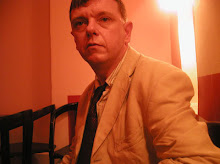My work does not go edge to edge. I choose only what is needed and simply leave out everything else. This creates A void of white. Many artists use voids to focus the eye though these voids are more often very dark or even black. Caravaggio would probably be the greatest exponent of this technique.
To get my void I trace around the outer edge of the composition in the centre of the board and mask out the outer area to preserve the white. Painting straight onto white can make colours look jumpy, sharp and somehow unrelated to each other. So I paint on a ground of dark brown which will give the final painting a warmer and more harmonious feel.
While the brown ground is still wet I place my drawing over the top and tape it down. Taking a 5H pencil I trace over the drawing. Drawing over the top has the affect of making the oil paint stick to the back of the paper. This leaves a white outline of the composition when I lift it off. Once this is dry I have a clear idea of where you need to paint and it will never rub out or shift. I can now begin the painting.


No comments:
Post a Comment